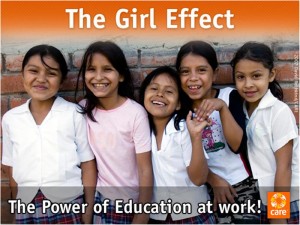The Girl Effect – The World’s Greatest Untapped Solution

THE GIRL EFFECT, n. — The powerful social and economic change brought about when girls have the opportunity to participate.
The focus of this blog has been on women’s consumerism and marketing to women. But in looking at the power of today’s women, we can’t ignore the power of the next generation of women around the world. I recently connected with a wonderful program called The Girl Effect – perhaps the greatest untapped solution for young girls in developing nations.
An adolescent girl is uniquely capable of raising the standard of living in the developing world and the community in which she lives: she will reinvest her income and knowledge back into her family and her community. As an educated mother and an active citizen, a girl will break the cycle of intergenerational poverty. That’s The Girl Effect. But despite her proven potential, she is also more likely to be uneducated, a child bride, and exposed to HIV/AIDS. Less than two cents of every international development dollar is directed to adolescent girls. And excluding these girls doesn’t just impact them, but the world at large.
The Girl Effect is the powerful social and economic change brought about when girls have the opportunity to participate. It’s an untapped force in the fight against poverty, and it’s driven by champions around the globe: the Nike Foundation, the NoVo Foundation, the UN Foundation, the Coalition for Adolescent Girls, CARE, Plan, the Population Council, ICRW and the Center for Global Development – and many others.
THE GIRL EFFECT DATA
Little research has been done to understand how investments in girls impact economic growth and the health and well-being of developing communities. This lack of data reveals how pervasively girls have been overlooked. For millions of these girls, there have been no systems to record their birth, their citizenship, or even their identity. They are virtually invisible. However, existing research suggests their impact can reach much further than expected.
- Today, more than 600 million girls live in the developing world.
- She’s the economic backbone of her family: the chore doer, the caretaker, the insurance policy.
- She’s the mother of the next generation. She will reinvest 90 percent of her income into her family, generating a powerful ripple effect. Her brother? Thirty to forty percent.
- When she’s educated through secondary school, she’ll bring 25% more income into her family.
- When she’s healthy, her community’s health will improve as maternal mortality and child malnutrition drop, and HIV rates decline.
- When a girl in the developing world receives seven or more years of education, she marries four years later and has 2.2 fewer children.
- An extra year of primary school boosts girls’ eventual wages by 10 to 20 percent. An extra year of secondary school boosts wages by 15 to 25 percent. But one-quarter of girls in developing countries are not in school.
- More than one-quarter of the population in Asia, Latin America, the Caribbean, and sub-Saharan Africa are girls ages 10 to 24.
- One girl in seven in developing countries marries before age 15, and 38 percent marry before age 18.
- One-quarter to one-half of girls in developing countries become mothers before age 18; 14 million girls aged 15 to 19 give birth in developing countries each year
What can you do? Help make these 600 million girls visible by becoming a fan of The Girl Effect on Facebook. Tell the world that you think these girls deserve better – for themselves, and for the end of poverty.
